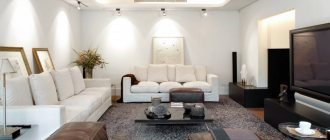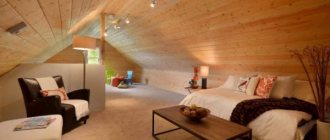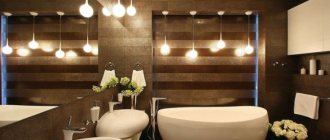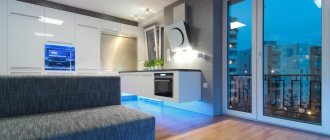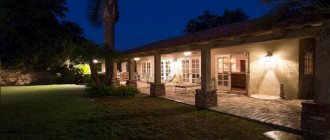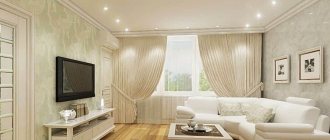Insufficient lighting negatively affects the human body. If there is not enough light, then a person feels constant drowsiness, vision deteriorates, and psychological state is disturbed.
High-quality lighting in the apartment will help avoid such problems. To do this, you need to select suitable lamps, lighting equipment and place it correctly.
To properly organize lighting, you need to take into account the power of the lamps, their color temperature, the number of lamps, the size of the room, etc.
There are many types of fixtures that can be successfully used for lighting.
How to properly organize lighting
First, you need to know that lighting in an apartment can be background or local. In the first case, ceiling chandeliers are used, which evenly illuminate the room without dividing it into separate zones. In the second case, devices are used that emit directional light (spotlights, sconces, table lamps). They divide the room into separate functional areas (working, cooking, reading areas), and highlight certain objects or interior features.
To choose the right lamps and fixtures, you need to draw up a lighting plan, taking into account the layout of the rooms, shape, ceiling height, arrangement of furniture, etc. The types and installation locations of fixtures should be noted on the diagram. An approximate plan for the distribution of devices is shown in the photo above.
Norms of power and number of lamps in a room
Not all people think about how to properly organize lighting at home, so they often make mistakes, then the light turns out to be too bright/dim or there are dark areas. To avoid this, you need to know the lighting standards:
| Room type | Illumination in Lux |
| Bathroom | 50 |
| Hallway | 50 |
| Living room, kitchen | 150 |
| Children's | 200 |
| Cabinet | 300 |
Attention! In the bathroom, it is permissible to increase the illumination to 100 Lux to make it comfortable to apply makeup or shave.
Lamps always indicate the luminous flux, which is measured in Lumens. To calculate their number, knowing the appropriate degree of illumination for a particular room, use this formula: 1 Lx = 1 Lm/1 m². First, determine the Lx rate, then convert the value to Lm, after which you can select suitable lamps.
Example calculation for a bedroom with an area of 20 m²: first multiply 150 (lighting rate) by 20 (area), you will get 3000 Lux. Based on this, the total luminous flux of the lamps should be equal to 3000 Lm. If you opted for LEDs, then you will need 3 devices of 12 W each, which corresponds to about 360 Lm.
The following table will help determine the number of lamps according to their power:
| Filament lamp, power (W) | Luminescent, power (W) | LED lamp, power (W) | Luminous Power (Lm) |
| 20 | From 5 to 7 | 2 – 3 | Up to 250 |
| 40 | From 10 to 13 | 4 – 5 | Up to 400 |
| 60 | 15 – 16 | 8 – 10 | Up to 700 |
| 75 | 18 – 20 | 10 – 12 | Up to 900 |
| 100 | 25 – 30 | 12 – 15 | Up to 1200 |
| 150 | 40 – 50 | 18 – 20 | Before 1800 |
| 200 | 60 – 80 | 25 – 30 | Up to 2500 |
The correct lighting can be determined using a lux meter.
Some experts recommend using lamps with a total power of up to 60 kW for every 5 m². Based on this, in a one-room apartment (30 - 40 m²) you need to install up to 8 devices of different types, in a two-room apartment - 9 pieces, in a three-room apartment - 11 pieces, in a four-room apartment - 13 pieces.
How to check the quality of light
It is important to choose the right lamp so that it emits comfortable light. You can find out this using a low-power device that runs on a solar battery, for example, a calculator. The procedure goes as follows:
- “Calibrate” the device with a filament lamp (40-60 W). Be sure to measure the distance at which the battery fired.
- Bring it close to a fluorescent light source (13-24 W), if the battery activation distance has decreased to 2.5 times, then the light is comfortable. If you are testing a lamp at 9 - 11 W, then this distance will decrease by another 1.5 times.
For example, if the battery provided operating current at a distance of 60 cm from a lamp with an incandescent filament or 15 cm from an 11 W housekeeper, then make the following calculations: 60: 15 = 4, and 2.5 x 1.5 = 3.75. This light is only suitable for local illumination.
Comfortable color temperature
The lighting of the apartment should be pleasant to perceive, so you should take into account the color temperature, which is measured in K (kelvins).
This is interesting! Comfortable artificial lighting should resemble sunlight as much as possible.
Color temperature of lamps used in apartments:
- From 3500 to 5500 K is a bright white light that does not distort colors. Can be used in any room.
- More than 5500 K is cold radiation, which sets you up for active activity. Suitable for office or kitchen.
- From 2700 to 3500 K - a warm glow of a yellowish tint. This lighting is ideal for the bedroom and living room.
As you can see, the requirements for the light temperature of lighting elements differ for different rooms.
Nuances to consider
Since there is a huge variety of layouts for the living, working and auxiliary areas of apartments, and their owners want to satisfy personal needs, the lighting layout must take into account many nuances. Therefore, we will consider these features separately.
Calculation of the number of lamps and power standards
The number of lamps according to the power standard is determined from the ratio of power consumption and output luminous flux. Depending on the type of lighting lamps, each kilowatt of electricity consumed will produce a different luminous flux. The most effective today are LED lamps with a power of about 80 - 100 Lm/W.
For example, if you need to provide a luminous flux of 3000 lm for a hall of 15 m2, then this will require from 30 to 38 W of power. Let's take the maximum, then 4 LED lamps of 10 W each will suit you, the result will be 40 W of power with a flux of 3200 Lm.
On the other hand, not only the illumination needs to be checked, but also the strength of the wiring. So, the power consumption must correspond to the throughput of the cores.
It can be calculated or taken from the table:
Table: checking power by wire cross-section
If you have a cable with a cross-section of 1.5 mm2 to power a chandelier or spotlights, then when using 40 W of power, the wire allows you to turn on a load of 4.1 kW, so the selected devices more than meet the safety requirements.
Checking the quality of light
But it should be noted that in practice, the actual illumination directly on any surface may differ significantly from the previously obtained calculated data. This is determined by the type of chandelier shades, location in relation to furniture and interior elements, supply voltage, etc. That is why the quality of lighting is checked using a lux meter, which determines the result obtained in practice.
Colorful temperature
Color temperature for lighting devices refers to the level of radiant heat.
This parameter determines the type of lamp glow:
- Warm;
- Neutral;
- Cold.
Temperature is measured in Kelvin, for example, incandescent lamps produce a luminous flux closest to that of a bright sunny day, which is in the range of 2000 - 3000 K - this is the warm range. If you shift to 6000 - 8000 K, then it will be a cold glow, and between them there is neutral light, which can shift in one direction or another. The specific lighting temperature is selected depending on the purpose of the room in the apartment.
Figure 1: Glow color temperature
Color rendition of lamps
The luminous flux from lighting devices, hitting any surface, is reflected, as a result of which we perceive the basic parameters of the surrounding space. However, each color can have different shades if it is hit by a different wavelength, which is expressed by the color rendering index CRI; the optimal value is considered to be from 100 to 80. An example of the perception of the color of the same object is shown in the figure below:
Rice. 2: color rendering coefficient
Therefore, color rendering is selected as a derivative of the color temperature of lighting devices. It is selected depending on the room in the apartment and the activities performed in it.
Illumination
The illumination in the apartment may be uneven, especially since some lighting components will be decorative in nature. For example, in each room you can install the main lighting in the center of the room, which will set the main background when you are in the room. But in those target locations where it is necessary to increase the degree of illumination, additional stationary (soffits, sconces, strips) or portable lamps (table lamps or floor lamps) are installed.
To adjust the degree of illumination, step systems are widely used:
- chandeliers with multi-key switches;
- dimmers with dimmable lamp;
- several devices with the same or different lamps.
By combining different systems in one room, you can qualitatively change the lighting, add additional effects, etc.
Lamp location
Depending on the location where lighting devices are installed, it is generally accepted to install the chandelier in the center of the ceiling. However, with the introduction of spotlights, this trend began to be supplemented or completely eliminated. Therefore, today the principle of arrangement of lamps is not only functional, but also decorative. The figure below shows several interesting options, but if you wish, you can change them and adapt them to your own apartment.
Rice. 3. Example of luminaire placement diagrams
Additional sockets and switches
The wiring and lighting diagram of the apartment is drawn up in advance; at this stage, not only the possibility of switching on from any point is taken into account, but also the ability to navigate the mounted switches. Therefore, for each room it is necessary to delimit lighting zones from different switches or several keys, but at the same time, several switches are enough for you so as not to get confused in them.
When planning the connection of pass-through switches, take into account the double consumption of cable or wire. And when connecting an outlet and a switch, each of them must receive power from the distribution box; you should not connect the outlet from the lamp and vice versa.
Shadows
When planning the installation location of lighting devices in the apartment, be sure to take into account the shadows they cast. Otherwise, illiterate placement will lead to a significant reduction in the coverage area of the lamp, a decrease in its efficiency and will negate the power of the light bulb. Chandeliers, sconces and floor lamps that are at human level deserve special attention in this regard. Since the light flux from these devices intersects with a much larger number of interior items, the shadow from which can darken even the brightest room.
Decorative lighting in the floor and window sills
Rice. 4. Decorative floor lighting
Recently, decorative lighting has covered more and more details in the apartment:
- Ceilings;
- Floor;
- Furniture;
- Doorways;
- Windows and window sills.
Decorative lighting can be used both solely for decoration and as a night light, illuminating the space in the apartment or highlighting individual contours, which will also help to navigate in the dark. Spot lighting devices, LED strips, flexible neon or fiber optic cords are used as decorative lamps.
Light sources at home
During the day, the apartment is illuminated by sunlight, the intensity of which depends on the direction of the windows. And in the evening or on cloudy days, chandeliers, floor, wall, table lamps, etc. are used. The light should be uniform so that a person feels comfortable and does not spoil vision.
Natural
The sun's rays are responsible for natural lighting. Diffused light in the room is obtained if the windows face north. Light walls will help increase illumination, while dark walls will absorb sunlight.
The level of natural light in a room is reduced by 30% if the windows are covered with dust.
South windows make the lighting too harsh, especially in the warm season. Then people are interested in how to make the light softer. For this purpose, you can use tulle, organza curtains or vertical fabric blinds.
Artificial lighting
Apartment lighting includes a variety of lighting devices. It is recommended to install 2 or more devices in each room. This is necessary so that the area is evenly illuminated and there are no sharp shadows or blinding reflections.
Interesting! The choice of lighting devices is huge; they differ in design, shape, materials, and colors. Modern models of lamps with a dimmer (dimmer) are gaining popularity.
Ceiling chandeliers provide even illumination, and floor, wall and pendant lamps allow you to illuminate individual areas of the apartment. LED strips highlight interior features.
Is it better to use cold light?
In the work area (at the desk or in the office), it is important for us to be active, feel cheerful and focused. The temperature of the light can help with this: warm light relaxes us, and cold light invigorates us. Therefore, in the work area it is better to install light bulbs with a temperature of 4,000–5,000 K - these are also installed in offices.
If you work with color (for example, design), then, among other things, accurate color rendition is important to you. For domestic use, this indicator must be at least 80 Ra/CRI. Ideally, 95 Ra/CRI, but few manufacturers are currently producing such lamps.
In addition, for any work, the light should be uniform and diffused, and shadows should be kept to a minimum. The golden rule from childhood works here: “If you write with your right hand, then the light should come slightly to the left.” It is better that there are no glare effects at all in the work area: they will tire the eyes, which means that you need to be careful with glossy surfaces and adjust the height of the light to a comfortable level.
Selection of lamps and fixtures
Properly organized room lighting will allow you to hide flaws, highlight advantages, change proportions, and zone it. To do this, it is important to choose lamps and fixtures. But lighting elements are especially important, on which the degree of illumination, light power, etc. depend.
Optimal light bulbs for everyday use
The following lamps are used for lighting:
- Incandescent lamps are comfortable for vision, but they heat up too much, have a short service life, and consume a lot of electricity.
- Halogen light bulbs use less electricity than regular bulbs, but they get very hot. They emit directional light, so they are often used for zonal lighting.
- Fluorescent light sources barely heat up, they are economical, and have a wide spectral range. However, they emit an unpleasant hum and contain mercury vapor.
- LED lamps are strong, safe, durable, energy efficient, and their range is wide. However, they are expensive, and many fakes have appeared on the market, so you should choose proven devices src=»https://svetilnik.info/wp-content/uploads/2019/03/Led-lampy.png» class=»aligncenter» width ="497″ height="311″[/img]
Fluorescent and LED lamps are more often used for lighting.
Optical fibers and duralight tapes based on diodes are used for additional lighting to highlight interior elements.
How to select lamps: main criteria
When choosing lighting equipment, you should consider the following rules:
- Buy a product from a trusted manufacturer.
- The lamp must match the design of the room.
- Decide on the color and material of the device. For example, a chandelier in calm tones with glass or fabric shades is more suitable for a classic interior.
- Choose a device based on the size of the room.
- Decide on the function of the device: decoration, functional lighting.
If it is difficult for you to choose a lighting device on your own, then consult a specialist.
Meaning and types of light
We need light just like air, water, food and warmth. Sunlight has a beneficial effect on the body: it increases immunity, stimulates the nervous system, and improves mood. Lighting is responsible for the visual perception of the interior. The most modest bedroom decor seems homely warm when the sconce is turned on. It is pleasant to relax in the living room when soft diffused light flows through the lampshade of the floor lamp. If you illuminate your bedroom with bright fluorescent lamps, it will resemble a museum. By replacing a fabric lampshade in the living room with a blue glass bulb, you can get special effects for a science fiction film. The same colors, shapes and sizes of objects are perceived differently under different lighting conditions.
Good light can visually expand the space in a room, but its lack, on the contrary, “moves” the walls.
The following types of visits are distinguished:
- natural - its quantity depends on the following factors: geographic latitude of the area, time of day, transparency of the atmosphere, cloudiness, number and size of windows, their location relative to the cardinal points, etc.;
- artificial - created by lighting devices. It should be uniform and comfortable, not too dim, but not too bright.
Depending on the location, the light can be:
- general - lighting of the entire room or most of it;
- local - distributed over a certain area of the room. This is used to highlight functional areas in the interior: working, dining, etc.
Based on the direction of flow, lighting is divided into:
- diffused - creates a soft, relaxing light that dissolves in space;
- directional - represents a concentrated, isolated beam.
Types of lamps
The main part of the lighting device is the lamp. The principle of its operation is simple: electric current is converted into light energy. In everyday life, incandescent, halogen and fluorescent lamps are used.
An incandescent lamp is a sealed glass bulb filled with an inert gas. In its lower part there is a metal base with threads. It allows you to screw the lamp into the lamp.
Pros:
- relatively low cost compared to other types of lamps;
- low cost of lamps for them;
- ubiquity of application
Minuses:
- low efficiency;
- short service life;
- high energy consumption;
- low light output;
- high heat transfer
A halogen lamp is a refractory glass tube filled with an inert gas with the addition of halogens. Halogens reduce the evaporation of the filament and thereby increase its temperature, brightness and service life. At one end of the tube there is a base with “antennae”, with their help the lamp is attached to the socket.
Pros:
- high efficiency (a 35 W lamp produces the same amount of light as a 60 W incandescent lamp);
- long service life (about twice as long as an incandescent lamp)
Minuses:
- high price;
- high cost of suitable lamps
A fluorescent lamp is a sealed cylinder with electrodes at the ends, which contains fluorescent gas with the addition of mercury under low pressure. The inner surface of the flask is covered with a layer of a luminous substance - phosphor.
Pros:
- the lamp creates soft lighting that is comfortable for the eyes;
- lasts up to five times longer than an incandescent lamp;
- consumes little electricity (an 11 W fluorescent lamp produces the same amount of light as a 60 W incandescent lamp)
Minuses:
- sensitivity to humidity, sudden temperature fluctuations and power surges;
- high price;
- high cost of suitable lamps
So, we figured out the types of lamps and lighting. Now let's move on to how to properly arrange lighting in different rooms of the apartment? Conventionally, we will divide the rooms in the house into two groups:
- Residential: living room, bedroom, children's room, office;
- Household: dining room, kitchen, hallway, bathroom.
Options for placing lamps in different rooms
There are different options for lighting rooms, depending on their functional purpose. For example, the hallway needs bright light since there are no windows. And for the bedroom, soft light, which is complemented by wall or floor devices, is more suitable.
Living room, hall
It is recommended to have multi-level lighting in the living room.
For background lighting, use a chandelier or several lamps. Floor, wall or tabletop fixtures will help illuminate a work area, a place to relax or receive guests.
When choosing several devices, make sure that they are in stylistic unity.
It is better to purchase devices from one set.
Bedroom
Bedroom lighting design should be cozy and relaxing.
To do this, you need soft light, which is provided by a chandelier or spotlights on the ceiling.
You can install a sconce or table lamp on the wall or bedside table.
Several small devices will help illuminate the mirror and dressing table.
Children's
Children's lighting should be comfortable, functional and safe. For background lighting, you can choose 1 chandelier, several pendant or recessed lamps made of impact-resistant plastic.
You can install a wall-mounted unit near the bed. On the study table, place a lamp with cold radiation, which stimulates mental activity. A night light will help your baby sleep peacefully.
The computer and TV should be turned on with background light so that the child does not damage his vision.
Kitchen
In the kitchen it is not necessary to use a chandelier; it is enough to install a pendant lamp above the dining table.
Choose models with adjustable suspension.
In addition, the kitchen cannot do without functional lighting.
To do this, install diode strips or point devices under the kitchen unit.
Hallway
The hallway is usually the darkest place in the apartment, since there are no windows. For background lighting, a chandelier, spotlights, or a combination of both are used.
If the ceiling in the hallway is low, then install luminous ceiling plinths. To expand a narrow room, place several spotlights along one wall so that their light is directed towards another. This technique will visually expand the space.
To illuminate the mirror, use small lamps, install them on top and on the sides.
Bathroom
For background lighting in the bathroom, you can use several spotlights. The following lighting option is also possible: 1 lamp on the wall and several built-in devices for illuminating individual zones.
Bathroom lighting should be safe. The best option is lighting fixtures with IP (moisture protection level) from 44 to 55.
The light should be as natural and warm as possible.
It is also important to install several wall lights above or on the sides of the mirror.
Types of lighting
Always consider the functionality of the room when choosing the type of lighting. There are three main types:
- reflected
- accent
- direct or directional
Direct is light from built-in or ceiling lamps shining strictly from top to bottom. This also includes table lamps.
Objects in this lighting will appear slightly larger than their actual size.
Indirect light sources are very suitable for the living room and bedroom, as they create a soft, evenly lit environment that is comfortable for the eyes.
Accent light is a bright, directional source. It is used where you need to draw attention to something, emphasize a separate object or element of the interior.
However, this light source has a big disadvantage - it is very blinding to the eyes.
Therefore, it must be used precisely, thoughtfully, and only where necessary and acceptable.
Light zoning in a studio apartment
A studio apartment is a room that is limited by load-bearing walls without partitions. This room has a small area, but allows you to implement new lighting ideas.
Lamps for each zone must be selected individually. To illuminate the kitchen, use spotlights or LED strip above the cutting surface and a pendant lamp above the table. You can install a sconce or floor lamp near the sofa or armchair. A wall-mounted device is needed in the recreation area. Place a lamp with a cool glow on your desktop. You can install several floor lamps in the living room.
Wall lighting
Never forget about lighting vertical surfaces. About 80% of our attention in rooms is focused on the walls.
When we move, communicate with each other, or simply sit in a chair, our gaze is always directed to vertical surfaces, and not to the ceiling.
The ceiling space takes up only 15% of attention, and the floor gets only 5%.
Therefore, if you want to get a comfortable room where it will be pleasant to be, do not forget about lighting the walls. In large living rooms, the concentration of lamps around the perimeter should be done based on this rule.
Ceiling lighting
When choosing devices for lighting an apartment, you need to take into account the height of the ceilings, the length of the rooms, the design, and the shape of the lighting device. And the lamps need to be selected taking into account the material of the upper level of the room. To visually expand or raise the ceilings in the apartment, you can install hidden lighting.
For low ceilings
It is better to purchase compact products whose horns are directed upward or to the sides.
An excellent option for low apartments are lampshades. You can also use soffits with a rotating mechanism.
It is recommended to point the devices at the ceiling, but not down, as the light will hit the eyes.
You can supplement the main lighting in low rooms with LED strips.
Hidden ceiling lighting
Hidden lighting can complement the main lighting or be used for decorative purposes. Spotlights and LED panels for such compositions are installed in a niche of a plasterboard ceiling or a special cornice.
Plasterboard ceilings with hidden lighting look very attractive, but when they are created, the height of the room is slightly reduced.
Interesting! Decorative polyurethane skirting boards with diode tape are much easier to install. This lighting allows you to visually raise the ceiling and expand the room.
Types of lighting
It can be general, directed and decorative.
- The general one will be useful to compensate for the lack of natural light - for example, if you need to brightly illuminate the room in the evening. This can be done by a chandelier in the center of the ceiling or a grid of built-in lamps.
- Directional lighting is also called task lighting. This category includes table lamps, floor lamps, and pendant lamps. It is needed to illuminate a small area: dining table, workplace, mirror.
- Decorative items add accents to the interior. This includes lighting of pictures and niches, built-in lamps in the floor and along the walls. If a light fixture casts complex shadows, emphasizes trim or decor, and does not serve a practical purpose, it is decorative.
Typically, all types of lighting are used in the interior. In some rooms you can get by with one or two options: the bedroom will be comfortable without a chandelier, and the toilet is unlikely to need complex lighting or a floor lamp. The purpose and number of lamps depends on how the room is used.
Decorative lighting
Decorative lighting will help hide imperfections, highlight interior features, and create the right atmosphere in the apartment. For this purpose, neon lighting, glass blocks, LED strips, etc. are used. When choosing lighting devices, you need to take into account the level of natural light, the purpose of the room, its design, color scheme, the set of surrounding furniture, and decorative items.
Neon lighting in the apartment
You can complement the lighting in your apartment with neon strips. These devices can be used to illuminate a stretch or multi-level ceiling, or to illuminate a cornice. They are also installed on wall panels, columns, walls, and partitions. Neon strips are used to illuminate the floor, podium and steps. Illuminated signs make the interior more original and festive.
Glass blocks with lighting in the interior
Glass blocks allow you to create unusual lighting effects in your apartment. These structures, consisting of double glass “bricks” with a relief or smooth surface, perfectly transmit light, which is refracted when penetrating inside, making the room brighter and more spacious. Glass blocks with luminous elements, inside of which lamps are installed, look especially beautiful.
Floor lighting
Lighting of the lower tier of the room is carried out using recessed lamps or diode strips. They are installed in the floor, the lower part of the walls, baseboards or under furniture. This lighting looks original and visually enlarges the room.
A staircase in an apartment can also act as an element of lighting decor. Glowing steps look very unusual, and besides, they are practical.
Design lighting in advance
Always start designing your lighting system as early as possible. Through our eyes we receive more than 90% of information about the world around us.
Light is the conductor through which a nondescript room can be transformed into a beautiful interior without much effort.
Furniture and paintings will acquire their true color.
Therefore, the lighting concept must develop together with the interior concept. This will save you from many mistakes and make the interior complete, beautiful, and well-lit.
Modern trends
Modern lighting is designed to increase the level of comfort, simplify everyday tasks and make the home safer. To do this, you can organize night lighting in the apartment, install motion sensors that automatically turn on the lights, and use wireless lamps. These devices are easy to install, comfortable, functional and help reduce electricity costs.
Night lighting in the apartment
Night lighting can be used to complement the main lighting; it will help you move around the apartment unhindered at night. For this purpose, lighting devices with motion sensors, luminous baseboards, panels, and products built into walls or floors are used.
Motion sensors
Modern apartments use indicators that react to human presence and turn on the lights. Based on their mechanism of action, the following sensors are distinguished:
- Infrared – recognizes human thermal radiation and the light automatically turns on.
- Ultrasonic and microwave - have a similar mechanism of action, but are triggered using sound waves.
Attention! The sensors can be installed in the corridor, hallway, kitchen (under the cabinet), bathroom, and also on the stairs. The only place where it is not recommended to place the device is the bedroom.
Wireless lamps
Wireless devices are used as night lighting, and they are also indispensable for illuminating dark places in the apartment, to which it is difficult to route wires. Depending on the installation method, there are ceiling, wall, and tabletop devices.
They are compact, lightweight, so they can be used almost anywhere. There is a wide range of wireless lamps that differ in design, design, and type of light.
Lighting in utility rooms
How to choose lighting for the dining room
The dining room should have a comfortable and relaxing atmosphere that encourages communication.
- general light - one or two chandeliers and several local sources, depending on the size of the room. The main chandelier must be placed directly above the table, since it is the most significant piece of furniture. If the dining group is moved from the central part of the room, then the chandelier should also be moved. A good option is a chandelier with adjustable height, which can be lowered to create a warmer atmosphere or raised higher, making the atmosphere more formal. It is better to avoid halogen spotlights above the table, as they look “office-like” and create harsh light.
- local lighting depends on the style in which the room is designed: for the classic style, sconces hung symmetrically on the walls are suitable; In a modern room, spotlights along the contour of the ceiling, covered with frosted glass, are appropriate.
- Decorative lighting is used extremely rarely. When using such lighting, it is important not to overdo it, so as not to disturb the atmosphere of comfort and tranquility.
How to choose lighting for the kitchen
Any kitchen, regardless of size, has two zones: working and dining. They are lit differently.
- general light: for a small kitchen one chandelier with two or three shades is enough. They will provide bright, even lighting. In a spacious room, lighting will have to be created using several sources: the main chandelier and lamps located around the perimeter. If the kitchen has a clearly defined dining area, then you will need a separate chandelier above the table.
- local lighting: the work area is the basis of the kitchen. It should have bright but soft lighting. Fluorescent lamps along wall cabinets are perfect.
How to choose lighting for the hallway
The hallway is the border between the outside world and private life. The lighting of this part of the apartment is influenced by the layout. If the hallway is not separated from the living area, then in this case an orientation light is needed, which is on around the clock, which increases energy consumption. In this situation, it is logical to use lamps with motion sensors: when someone enters the hallway, the light will turn on automatically and turn off when the person leaves the range of the sensors.
- general light is provided by a ceiling chandelier. A single-lamp lamp with a matte shade or fabric lampshade is suitable for a small room.
- local lighting is organized either when there is a lack of general light, or for the convenience of the owners. In a spacious hallway, spotlights along the central axis or perimeter of the ceiling are allowed for additional lighting.
How to choose lighting for the bathroom
The bathroom should be perhaps the brightest place; here people take care of their face and body, and this requires bright and even light.
- general light - depends on the size of the room. A small room can be illuminated with a chandelier with a matte shade or a lamp over the sink. In a spacious bathroom, multi-position lighting is used - additional lamps are placed at important points: near the mirror, cabinet, bathtub or shower stall. In a room with high ceilings, it is better to use reflected light, which is created by a lamp with a mirror or metal reflector.
- local lighting is used above the sink and the adjacent mirror. A good option is symmetrical lamps with matte shades on both sides of the mirror.
- Decorative lighting is rarely used.
OK it's all over Now. We told you about the types of lighting lamps, how to choose harmonious lighting for each room in the house, and we hope that our tips will be useful to you.
How is the lighting organized in your apartment? Did you learn anything new in our article? Be sure to tell us about it in the comments.
Didn't find the answer to your question? Then ask it in the comments and we will definitely expand and improve this article.
Main conclusions
When choosing lighting for an apartment, you need to consider the following parameters:
- Power.
- Luminous flux level.
- Degree of illumination.
- Colorful temperature.
- Room dimensions.
- Shape, dimensions, design of lamps.
It is necessary to immediately draw up a lighting plan for all rooms. In almost all rooms, multi-level lighting is used: main lamps with diffused light and devices with directional radiation to highlight individual zones. The best option for residential premises is LED lamps. LED panels, neon strips, glass blocks, and built-in products are used to create decorative lighting. Night lighting, motion sensors and wireless lamps will help increase comfort and safety in the apartment.
Previous
Lighting in an apartmentHow to calculate how many lumens are needed per square meter in an apartment or other room
Next
Lighting in an apartment How to translate correctly and what is the difference between lux and lumen
in the children's room?
The nursery requires one hundred percent attention to all key indicators, and the most important here is safety. Children should not be able to open the lamps themselves, so the lamps in the nursery should be as shock-resistant as possible. There are cases when anti-vandal lamps that are designed for street lighting are used in children's rooms: they are usually made of powerful fiberglass. In addition, in rooms for children it is better to use 12 or 24 volt lamps - in case the children get to the electrics.
In the nursery, it is worth providing several levels of lighting: children study, play, they need to read a fairy tale before bed. For example, uniform central light from the ceiling is needed so that the child can play calmly on the floor. If we are reading a book, we need a local floor lamp; if we are doing homework, we need local lighting for the table. For training, you need maximum color rendition, and to avoid getting tired, no glare effects. If children play video games, then the background light must work along with the TV, otherwise they will damage their eyes.
When children are very young, life is made easier by directional lights - track lights or night lights, so that you can easily see something in the room, but without waking the baby with bright light. For fun, you can make LED dual strips, where there is a colored and a white stripe: children love to play with the lights of different colors. However, they grow quickly, so it is better to approach such special effects and special children's lamp models wisely.
Tips for choosing lighting in an apartment
Today in our stores you can buy lamps, floor lamps, chandeliers of various shapes and colors, choose lighting for one room or an entire apartment in the same style. Fashionable lamps are made from metal, glass, wood, plastic, fabric, wicker and even rice paper. Expensive models are equipped with a rheostat, which allows you to reduce or increase illumination to the desired level. It is known that the breadth of choice, as well as the lack thereof, gives rise to problems. First of all, you need to decide what kind of lamp is needed. To illuminate the apartment, incandescent, halogen, and fluorescent lamps are used, including energy-saving compact ones. Incandescent lamps give the interior a faint yellow tint, while fluorescent lamps give a cool blue or greenish tint.
The overall illumination of a room can be considered sufficient if there are from 15 to 25 watts of incandescent lamp power per square meter of area. Sufficient illumination of a sheet of whatman paper when drawing is provided by a lamp with an incandescent lamp with a power of 150 watts at a distance of 80-100 centimeters. It is better to knit, embroider, and darn with black threads at 100 watts at a distance of 20-30 centimeters, and to read at 60 watts.
Chandeliers, the light of which is directed upward to the ceiling or evenly scattered throughout the room, create the softest lighting, which is why they are most often purchased for bedrooms. It happens that you need to illuminate some part of the room, for example a dining table, in this case a lamp that directs the flow of light downward is suitable. For high ceilings, pendant lamps are good; make sure that the distance from their lowest point to the floor is 2-2.3 meters, no less.
For a living room or dining room, just a 100-watt ceiling light is not enough. It will emphasize contrasts and thereby tire the eyes. In such rooms there should be a sitting corner where you can read under the light of a floor lamp. Sconces, floor lamps, wall soffits and pendant lamps create a multi-level lighting composition and allow you to change its intensity in different corners of the room, highlighting individual fragments of the interior. To focus attention on paintings, sculptures, flowers, it is better to use miniature finger lamps with a white glow and mobile mounting on the wall or furniture.
For a small area, one chandelier on the ceiling is enough. If necessary, you can hang two in a spacious room.
Lamps decorate the house; their function is not limited to the utilitarian side. A luxurious chandelier, as a rule, is the main one in the interior, and compact lamps are placed on tables, shelves, bedside tables, where they play a decorative and subordinate role. A bright table lamp shade can become the main color accent in the room. It is fashionable to illuminate not only walls, but also floors, as well as illuminate aquariums and potted plants. The lower light from the fireplace and floor lamp adds mystery to the interior.
The source of general light should be located above the main part of the room.
In the hallway today, many people prefer a paper lampshade; its warm, evenly diffused light does not hurt the eyes. If there is a mirror, then wall lamps with a power of at least 60 watts are hung on both sides of it at head level. They are placed with some distance from the edge of the mirror so that the reflection of the lamp in the mirror does not fall into the field of view.
The bedroom can have not only a ceiling lamp, but also a sconce with a directional beam of light and a rotating or adjustable bracket. Modern youth prefer plastic spotlights with a halogen lamp, which are mounted on the wall or ceiling and rotated in any direction. They are convenient for illuminating the bed and dressing table. To create an atmosphere of peace and comfort, it is better to use side light of a yellow, orange or reddish hue.
The children's room is traditionally illuminated with overhead light; funny, unbreakable night lights look very good here. Particular attention is paid to the child’s workplace, because his vision largely depends on this. Use a wall lamp on a sliding bracket or a lamp with a hinged or flexible connection, which allows you to direct the light flux to any place on the table and at the desired angle. If the child is right-handed, the lamp is installed in front on the left, if left-handed - on the right. At the desk, you need bright white light from an incandescent lamp with halogen, iodine or bromine vapor.
The kitchen, as a rule, is illuminated by a central ceiling lamp with a 60-75 watt lamp and small lamps placed under wall cabinets above the surface of the hostess’s desk - this is the so-called local light. Here you can use not only ordinary incandescent lamps, but also halogen and fluorescent lamps.
In the bathroom it is advisable to have two types of lighting: general - with diffused light and directional - to achieve a clear image. General lighting is provided by a lampshade with an incandescent lamp. Diffused light highlights all the corners and shelves in a small room. The mirror above the washbasin should have two light sources on the sides, creating uniform lighting without shadows. As in the hallway, the lamps are installed in such a way that they are not reflected in the mirror. A common mistake is vertical mirror lighting: directed from top to bottom, it emphasizes wrinkles, and from bottom to top, it creates shadows on the face.
In bathroom
Bathroom lighting is critical - it must be well planned to prevent glare and shadows. Properly selected light creates a relaxing environment and improves your mood. When arranging lamps in the bathroom, it is necessary to take into account the areas where daily hygiene procedures will be performed, such as applying makeup, shaving, etc. Waterproof LED strip is ideal for interior lighting of areas exposed to high humidity. Glued inside the aluminum profile, the tape will serve for a long time. After all, the LED is, in fact, an almost eternal device. Read more about bathroom lighting in the article.
Lighting in the house: what light is suitable for different areas
Did you know that the atmosphere and style of a space changes depending on the lighting?
Finding the right lighting in your home is very important. In a large space, such as a living room, a lamp that can illuminate everything is appropriate. In the case of an office desk, a lamp with direct light and adjustable intensity is suitable. The bedroom should be a little toned down to create a calm and peaceful atmosphere. Blurry lights are a smart choice.
Proper lighting in the house.
The range of lighting fixtures includes ceiling lamps, table lamps and floor lamps. Miconos, Plane Round, Curve Ball and other classic models from the collection. Find the light that's right for your home.
Track lights in the apartment: no cons
Fashion and technology have changed significantly in recent years. And while chandeliers and LED strips have moved to the background, new lighting systems based on bus lights have rapidly gained popularity both among ordinary people and experienced architects and designers who use them in the design of modern interiors. Perhaps not everyone has yet encountered track lamps in the interior of an apartment. If you don’t yet know why these lighting devices endear you, then later in this review you will learn about all the features and advantages of bus lighting systems. Track lights on tires are rapidly gaining popularity as a home lighting device. Just imagine that the lighting can be moved according to your wishes. Only by changing the angle of light will you make the interior sparkle with new colors. 'Fantastic' - you say. No, reality! Track luminaires are a unique lighting system that combines technological progress and design aesthetics. Thanks to their qualities, they have won the trust of thousands of customers. If you want to find the disadvantages of bus lights, please, but there are none, but there are many advantages and you can verify this:
1. Durable. Track lamps will serve reliably for many years, as they are highly durable. 3. Busbar luminaires consume minimal energy, saving you money. 4. Mobile. You can change the luminous flux and place light accents simply by changing the position of the lamp. 5. Easy installation and installation (surface-mounted, built-in, suspended), as well as quick replacement if necessary. 6. The lamp on the bus is able to illuminate even the farthest corner of the space, since it is possible to adjust the direction of the light as desired. 7. Huge selection of models. Suitable for any interior and will create a pleasant homely atmosphere. 8. Using a circular busbar, you can assemble your own individual track chandelier that will have the functionality you need
nality
No matter how fashion changes, it is important to note that trends have shifted towards simple and concise forms. At the moment, minimalist lamps with a minimum amount or complete absence of decorative details are relevant. Modern lighting favors “smart” lighting design. Forget about expensive lamps and complex lighting schemes. Choose what you like. After all, the main thing is comfort and convenience!
Soul of the apartment: kitchen
To create a modern interior and a welcoming atmosphere, you need to combine at least two main types of lighting: general, the main purpose of which is to provide a good and comfortable level of visibility; local, helping to highlight and decorate certain aspects, at the same time, allowing you to visually make the room more spacious and stylish. When choosing kitchen lamps, the first thing to consider is the color of the walls. Dark walls reflect less light, so you should choose lamps that have more light output. If the color of the walls is bright, then accordingly you need to choose LED lamps with a lower luminous flux. When allocating separate kitchen areas, it is important to take into account the places where the housewives' daily tasks will be performed - the area around the stove, work table and sink.
Recessed luminaires
Instead of the strong and too bright light of traditional lamps, modern recessed ceiling lamps allow you to control the light, dimming or, conversely, increasing the brightness of the light in the kitchen. The main criterion when choosing recessed ceiling LED luminaires is technical characteristics and aesthetic appearance. In our assortment you can find both classic models and the most modern solutions.
Recommended series:
- Round lamps
- Square lamps
- Cardan and rotary lamps
- Downlights
Read more about kitchen lighting in the article.
